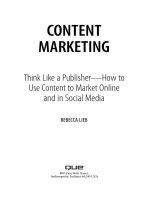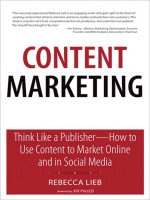Content marketing think like a publisher how to use content to market online and in social media by rebecca lieb
Bạn đang xem bản rút gọn của tài liệu. Xem và tải ngay bản đầy đủ của tài liệu tại đây (6.65 MB, 193 trang )
Praise for Content Marketing
“The Web democratized access to publishing, but didn’t come with an instruction manual. I
don’t know anyone more qualified to write that manual than Rebecca. If you aspire to be a
competent publisher, peek inside the concepts and processes that keep the great publishers on
top.”
—Ted McConnell, EVP Digital, Advertising Research Foundation (ARF)
“The massively experienced Rebecca Lieb is an engaging writer who gets right to the heart of
creating content that attracts attention and turns readers and watchers into customers. This easyto-read, how-to primer is a must-read for beginners who need a clue and old timers ready for a
refresher. This book is crisp but not trivial, comprehensive but not ponderous, and useful but
not pedantic. You should have bought it by now.”
—Jim Sterne, eMetrics Marketing Optimization Summit
Founder and Web Analytics Association Chairman
“Content marketing is about optimizing the dialogue between a company and its customers for
profitable outcomes. The better the conversation is, the more attention it attracts, and the more
your customers are compelled to talk and buy. Almost any company or service can find a
content marketing strategy that will work for it. And with an economic forecast that’s
challenging for at least the near future, it’s easy to make a case for leveraging content for all
it’s worth. This book explains the nuts and bolts of content marketing, from developing a
strategy to putting it into practice to measuring and improving results. If your business has any
kind of a digital presence, from a website to a Facebook page or a Twitter account, you can’t
afford not to read it—now.”
—Bryan Eisenberg, marketing speaker and co-author of The Wall Street Journal,
BusinessWeek, USA Today, and The New York Times bestselling books Call to
Action, Waiting For Your Cat to Bark?, and Always Be Testing.
“Content creation can be a tough task, but there’s no one in this industry that understands the ins
and outs of creating highly valuable and thoroughly optimized content like Rebecca Lieb. These
days, it’s not just about putting words up in a blog post, and Rebecca is one of the top
authorities to teach marketers how to create content that resonates with their audiences, social
communities, and search engines. If you’re going to buy any book to teach you about creating
valuable content for your audience, it should be this book!”
—Liana “Li” Evans, author of Social Media Marketing:
Strategies for Engaging in Facebook, Twitter & Other Social Media
“Many books on digital marketing are glorified blog posts—one good idea painfully stretched
out over hundreds of pages. Content Marketing is something different; a rich and useful study
of the new engine of marketing. Whether you sell locally or across the globe, you will come
away with a new understanding of how to build a powerful content strategy and the tactics to
make it work.”
—Stefan Tornquist, VP Research for Econsultancy U.S.
“Content is king. Unless it’s not. Content Marketing will ensure a brand’s content is always
kingly, always works towards increasing sales, and always reduces marketing costs.”
—Steve Hall, Adrants, Editor
“Clearly reflecting Rebecca’s deep digital publishing experience, this book provides step-bystep guidance on how to plan, produce, promote, and measure content marketing. Even more
importantly, as it’s often the greater challenge, it outlines how to integrate content marketing
into other existing marketing functions such as advertising, social media, etc.”
—Pauline Ores, Industry Principal, Infosys
Content Marketing
Think Like a Publisher—How to Use Content to Market Online and in Social
Media
Rebecca Lieb
800 East 96th Street,
Indianapolis, Indiana 46240 USA
Content Marketing: Think Like a Publisher—How to Use Content to Market Online and in
Social Media
Copyright © 2012 by Que Publishing
All rights reserved. No part of this book shall be reproduced, stored in a retrieval system, or
transmitted by any means, electronic, mechanical, photocopying, recording, or otherwise, without
written permission from the publisher. No patent liability is assumed with respect to the use of the
information contained herein. Although every precaution has been taken in the preparation of this
book, the publisher and author assume no responsibility for errors or omissions. Nor is any liability
assumed for damages resulting from the use of the information contained herein.
ISBN-13: 978-0-7897-4837-9
ISBN-10: 0-7897-4837-1
Editor-in-Chief
Greg Wiegand
Acquisitions Editor
Rick Kughen
Development Editor
Rick Kughen
Managing Editor
Sandra Schroeder
Project Editor
Seth Kerney
Copy Editor
Gill Editorial Services
Indexer
Brad Herriman
Proofreader
Apostrophe Editing Services
Technical Editor
Sally Falkow
Publishing Coordinator
Cindy Teeters
Book Designer
Anne Jones
Compositor
Trina Wurst
Library of Congress Cataloging-in-Publication data is on file.
Printed in the United States of America
First Printing: October 2011
Trademarks
All terms mentioned in this book that are known to be trademarks or service marks have been
appropriately capitalized. Que Publishing cannot attest to the accuracy of this information. Use of a
term in this book should not be regarded as affecting the validity of any trademark or service mark.
Warning and Disclaimer
Every effort has been made to make this book as complete and as accurate as possible, but no
warranty or fitness is implied. The information provided is on an “as is” basis. The author and the
publisher shall have neither liability nor responsibility to any person or entity with respect to any loss
or damages arising from the information contained in this book.
Bulk Sales
Que Publishing offers excellent discounts on this book when ordered in quantity for bulk purchases or
special sales. For more information, please contact
U.S. Corporate and Government Sales
1-800-382-3419
For sales outside of the U.S., please contact
International Sales
Dedication
For rbrt, source of a great deal of contentment.
Contents at a Glance
Introduction
Foreword
Part I: Content Marketing Basics
1 What Is Content Marketing, Anyway?
2 Why Is Content Important Now?
3 You’re a Publisher. Think Like One.
Part II: What Kind of Content Are You?
4 What Kind of Content Are You?
5 Content That Entertains
6 Content That Informs and Educates
7 Providing Utility
8 Content Curation and Aggregation
9 Finding a Voice
Part III: Getting Tactical: Content Nuts & Bolts
10 Overview of Digital Content Channels
11 Content and SEO
12 Content and PR
13 Content and Advertising
14 Content Marketing for Live Events
15 Content and Customer Service
16 Content and Reputation Management
17 User-Generated Content
18 Content Distribution and Dissemination
19 Whose Job Is Content?
20 How to Conduct a Content Audit
21 How to Analyze Content Needs
22 The Content Workflow
Part IV: It’s Never Over—Post-Publication
23 Listening...and Responding
24 Remaking, Remodeling, and Repurposing Content
25 Tools of the Trade
26 Yes, But Is It Working? Content Metrics and Analytics
Index
Table of Contents
Introduction
Foreword
PART I: CONTENT MARKETING BASICS
1 What Is Content Marketing, Anyway?
Digital Changed Everything
2 Why Is Content Important Now?
3 You’re a Publisher. Think Like One.
PART II: WHAT KIND OF CONTENT ARE YOU?
4 What Kind of Content Are You?
5 Content That Entertains
6 Content That Informs and Educates
Example: Wine Library
Example: Corning
Example: Sports Bras
Example: Hubspot
Example: Online Communities
Branded Content That Informs and Educates
7 Providing Utility
8 Content Curation and Aggregation
Examples
Finding Content
Don’t Be a Pirate
Aggregation, Filtering, and Curation Platforms
9 Finding a Voice
Spokesperson or Spokes-Character
PART III: GETTING TACTICAL: CONTENT NUTS & BOLTS
10 Overview of Digital Content Channels
Social Networks
Google+
Custom Social Networks
Geo-Social Networks
Location-Based Content
Online Directories
Blogs
Social Bookmarking
Online Video
Podcasts
Webinars
Twitter (and Microblogging)
Tumblr and Posterous
Long-Form Publishing (ebooks, Whitepapers, Digital Magazines)
Digital Media Center/Press Room
Apps and Widgets
Case Studies
Articles and Columns
Elearning/Online Training
Online Community
Wikis
Visual Information (Charts, Diagrams, Infographics, Maps)
11 Content and SEO
Keywords Are Key
Optimize Images and Multimedia Content
Quality Matters—So Does Specificity
12 Content and PR
Enter the Optimized Press Release
Find the Influencers (Not Necessarily the Journalists)
13 Content and Advertising
14 Content Marketing for Live Events
Before: Building Buzz and Interest
Hashtags—A Critical Underpinning
Social Media Channels
During: Building Engagement
After: You’ve Got Content!
15 Content and Customer Service
Anticipating and Addressing Need
Create Feedback Mechanisms
Creating One-on-One Communication
16 Content and Reputation Management
Crisis Management
17 User-Generated Content
Soliciting Ideas
18 Content Distribution and Dissemination
Contribute
Promote
Syndicate via RSS Feeds
19 Whose Job Is Content?
Job Description: Chief Content Officer
20 How to Conduct a Content Audit
Step 1: Create a Content Inventory
Step 2: Determine What Your Content Covers
Step 3: Verify Accuracy and Timeliness
Step 4: Determine Whether Your Content Is Consistent with Your Goals
Step 5: Note Whether People Are Finding and Using Your Content
Step 6: Verify Whether the Content Is Clean and Professional
Step 7: Take Stock of the Content Organization
Step 8: Evaluate the Tone of Voice
Step 9: Note the Keywords, Metadata, and SEO
Step 10: Identify Any Gaps
Step 11: Define the Needed Changes/Actions
21 How to Analyze Content Needs
Where to Start?
How Much, How Often?
When?
22 The Content Workflow
More Tools of the Trade
PART IV: IT’S NEVER OVER—POST-PUBLICATION
23 Listening...And Responding
Why Listen?
What to Listen For
How and Where to Listen
Involve Others and Assign Roles
Responding
24 Remaking, Remodeling, and Repurposing Content
Slice ‘n’ Dice
As You Listen, So Shall You Create Content
It’s Doubtful You’ll Be Repeating Yourself
25 Tools of the Trade
Social Networks
Listening Tools
Twitter Management
Twitter Analytics and Measurement
Content Sharing
PR
Blogging
Measurement and Analytics
Online Surveys
Audio/Video & Graphics
Keyword Research
Webinar Providers
Miscellaneous
26 Yes, But Is It Working? Content Metrics and Analytics
Establish a Measurement Plan
An Example of Business-to-Business Content Marketing Measurement
An Example of Business-to-Consumer Content Marketing Measurement
Web Traffic and Engagement
Sales
Qualitative Customer Feedback
Sales Lead Quality
Search and Social Media Ranking/Visibility
Conclusion
Index
About the Author
Rebecca Lieb is globally recognized as an expert on digital marketing, advertising, publishing, and
media. A consultant, author, and sought-after speaker, she is Altimeter Group’s digital advertising
and media analyst. Earlier, Rebecca launched and ran Econsultancy’s U.S. operations. She was VP
and editor-in-chief of The ClickZ Network for more than seven years. For a portion of that time,
Rebecca also ran Search Engine Watch. She consults on content strategy for a variety of brands and
professional trade organizations. Earlier, Rebecca held executive marketing and communications
positions at strategic eservices consultancies, including Siegel+Gale. She has worked in the same
capacity for global entertainment and media companies including Universal Television & Networks
Group (formerly USA Networks International) and Bertelsmann’s RTL Television. As a journalist,
Rebecca has written on media for numerous publications, including The New York Times and The
Wall Street Journal. She spent five years as Variety’s Berlin-based German/Eastern European
bureau chief. Until recently, Rebecca taught at New York University’s Center for Publishing, where
she also served on the Electronic Publishing Advisory Group.
Her first book, The Truth About Search Engine Optimization, published by FT Press, instantly
became a best seller on Amazon.com. It remains a top-10 title in several Internet marketing
categories.
We Want to Hear from You!
As the reader of this book, you are our most important critic and commentator. We value your opinion
and want to know what we’re doing right, what we could do better, what areas you’d like to see us
publish in, and any other words of wisdom you’re willing to pass our way.
As an editor-in-chief for Que Publishing, I welcome your comments. You can email or write me
directly to let me know what you did or didn’t like about this book—as well as what we can do to
make our books better.
Please note that I cannot help you with technical problems related to the topic of this book. We do
have a User Services group, however, where I will forward specific technical questions related to
the book.
When you write, please be sure to include this book’s title and author as well as your name, email
address, and phone number. I will carefully review your comments and share them with the author
and editors who worked on the book.
Email:
Mail: Greg Wiegand
Editor-in-Chief
Que Publishing
800 East 96th Street
Indianapolis, IN 46240 USA
Reader Services
Visit our website and register this book at informit.com/register for convenient access to any updates,
downloads, or errata that might be available for this book.
Introduction
Content-ment.
That’s what marketers of all stripes—from tiny, family businesses to multinational conglomerates—
are achieving though creating and disseminating content through digital channels: websites, social
media networks, blogs, video-sharing sites, newsletters, and more.
Instead of advertising, the shift is toward publishing. Instead of buying media, you can roll your own
and “be there” when potential customers are researching purchase decisions and gather information
about products and services.
The challenge? Learn how to think like a publisher to market in digital channels. Content marketing
isn’t merely a tactic; it’s a strategy. Companies that successfully address customer needs and
questions with content add value to conversations that take place online. They position themselves not
as “buy me!” banners, but as trusted advisors. Content can shape and create a brand voice and
identity. Most of all, content makes a company and its products relevant, accessible, and believable.
“Content marketing is no longer a nice-to-have. It’s a must-have.”
Content marketing is no longer a nice-to-have. It’s a must-have. It’s imperative that businesses create
content on an ongoing basis. They can’t create just any old content, of course. It must be relevant and
high quality. It also must be valuable and drive profitable customer interactions. And it must be about
customer needs and customer interests, not ad-speak, which is all about the “me.”
Marketers are buying less and less media. They’re becoming the media, and the best of them are
actually competing with “real” publications for audience, users, and eyeballs. Some marketers are
even beating publishers at their own game.
Content marketing isn’t new. Companies have been publishing newsletters and producing filmstrips
for decades. But a plethora of low-cost tools and ever-lower barriers to entry puts content creation in
everyone’s grasp at a time when consumers are becoming more cynical about advertising and are
better able to tune it out. (TiVO, anyone?)
The purpose of this book is to help anyone who needs to market a business think more like a publisher
to take advantage of content marketing. It explains the different types of content marketing. Do you
need to amuse and entertain? Inform? Teach? Provide customer service? You’ll also learn to assess
how and where you need to focus your own efforts.
This book also provides a review of content channels, from websites and social networks to ebooks
and webinars, and explains the advantages and disadvantages of each channel. We’ll review how to
determine content needs, and we’ll assign resources to create and disseminate content, while ensuring
that it’s accessible to the right audiences.
Finally, this book is intended to spark creativity and inspiration with examples of some of the best
(and most disastrous!) examples of content marketing in recent years.
This is all in the hopes this book will help you and your business find content-ment.
—Rebecca Lieb
New York City, 2011
Foreword
I first started using the term content marketing back in 2001. Until that point, it had rarely been
heard or used. Marketing and publishing professionals used a number of terms to describe the
concept of brands telling stories to attract and retain customers: custom publishing, custom
media, customer media, customer publishing, member media, private media, branded content,
corporate media, corporate publishing, corporate journalism, and branded media (just to name a
few).
Of all these, why content marketing?
Let’s first start at the beginning.
Marketing, as defined by Merriam-Webster, is the action or business of promoting and selling
products or services. Traditionally, companies have done this by buying attention through the use
of advertising and promotion through other people’s content. For example, if my customers read
the leading trade magazine, I would buy an advertisement in that magazine in the hopes that I
could divert their attention long enough to make an impact on my sales. It’s the same for
television, radio, and even buying display advertising on the Web.
In addition to advertising, marketers try to get their stories placed in traditional media. The biggest
brands in the world still spend billions on trying to get coverage from the press.
This type of marketing is not going away, but considering the thousands of messages that consumers
are inundated with on a daily basis, it’s harder and harder to cut through the clutter.
Enter content marketing. What if, instead of buying attention, we create content that is so informative,
valuable, and compelling that it positively affects the lives of our prospects and customers, and makes
an impact on our business? What if, instead of the traditional media, WE became the expert resource
for our customers?
What could that do for your business?
Online, in person and in print, how do you position yourself as the expert in your industry and become
the true resource? The answer: through great and consistent content.
Everyone creates content...but to be content marketing, it needs to do something for your business.
That’s why the term content marketing has resonated so much with marketing professionals...it’s
content that makes an impact, both on your customers and your bottom line.
Content Marketing Is Not New
Content marketing has been used since the dawn of cave paintings. John Deere and its customer
magazine The Furrow is given credit for the first content marketing initiative. At that time, farmers
needed to be educated on the latest in technology so they could be more successful. Instead of buying
attention, they created a print content initiative in 1895, teaching farmers all about the latest in
technology and trends for farmers. More than 100 years later and with 1.5 million in distribution to 40
countries, The Furrow could be the most successful content marketing initiative in history.
Since then, thousands of companies have used content marketing (to an extent), but never have we
seen marketing professionals focus so much on content marketing as we do today.
Why?
First, the barriers to entry are gone. As Newt Barrett and I discussed in our first book, Get Content
Get Customers, the following reasons have left the door wide open for brand marketers to become
THE publishers in their industry:
• Buyers accept content from corporate sources more than ever. In other words, you don’t have to
be The Wall Street Journal to find and engage readers.
• Buyers find 99% of purchase information by themselves. The consumer is now in complete
control and doesn’t care much for your sales processes.
• Shrinking media budgets are leaving an opportunity for YOU. The traditional media model is
hurting, and many of those media companies aren’t investing in content areas that YOU can cover
more effectively.
• The cost of content creation and distribution has significantly decreased. Frankly, with tools like
WordPress, the technology is essentially free, and Google, email, and better access to databases
let everyone have and use the tools of publishing.
• Content expertise is everywhere. Journalists, who in the past thought of corporate content
creation as the dark side, are now more than open to working with corporate marketers on their
content marketing initiatives.
But perhaps most important, and as Rebecca details specifically in Content Marketing, is there
another way? Content marketing is not an option anymore. If you want to grow your business, attract
new customers, and build long-term relationships with your current customers, you MUST have a
content marketing strategy. You have two choices: to inform your customers at the right time with
valuable and relevant content, OR entertainment. Good content marketing, as Rebecca discusses, does
both.
Although Get Content Get Customers showed marketing professionals the way, Content Marketing
will show you how to make this work for your business. Take this book, dog ear it, highlight it, share
it with your team, and take the next step to becoming THE informational expert to your customers and
prospects.
That’s what content marketing can do and will do for your business. Just read on and make it happen.
Good luck!
—Joe Pulizzi
Joe Pulizzi is the founder of the Content Marketing Institute and co-author of both Get Content Get
Customers and Managing Content Marketing: The Real-World Guide for Creating Passionate
Subscribers to Your Brand. Joe can be reached at , or just Google him at “Joe
Pulizzi.”
Part I: Content Marketing Basics
1. What Is Content Marketing, Anyway?
“Your customers have chosen the moment—all you have to do is be ready.”
Have you ever picked up a company’s brochure or flyer? Watched an infomercial or a shopping
channel on television? Ordered a product DVD explaining the benefits of a new mattress or a
vacation destination? Leafed through a company newsletter? Read the little comic strip in a
packet of Bazooka bubble gum?
All these are a few (but by no means an exhaustive list) of the ways companies use content to
market their products and services to customers and to prospective buyers.
Content marketing, in other words, is nothing new. Companies having been creating and
distributing content for many years, both to attract new business and to retain existing customers.
However, here’s the point of differentiation from more traditional forms of marketing and
advertising: Using content to sell isn’t selling, or sales-ey. It isn’t advertising. It isn’t push
marketing, in which messages are sprayed out at groups of consumers. Rather, it’s a pull strategy
—it’s the marketing of attraction. It’s being there when consumers need you and seek you out with
relevant, educational, helpful, compelling, engaging, and sometimes entertaining information.
When customers and prospects come to you, rather than the other way around, the advantages are
obvious. They’re interested, open, and receptive. Your customers have chosen the moment—all you
have to do is be ready. And it spares you much of the headaches and expense of outreach marketing
efforts:
• Media planning and buying.
• Direct mail dumps.
• Spraying and praying in an era in which browsers can be configured to block ads, spam filters
can be sending your email campaigns into oblivion, digital video recorders are making TV spots
optional, and consumers are emptying much of the content of their mailboxes into the Recycling
Bin.
There’s really no debate over the benefits of tune-in versus tune-out, of pull versus push.
A Roper Public Affairs poll found 80% of business decision makers prefer to get information about a
company from articles rather than from ads. Some 70% say content marketing makes them feel closer
to the sponsoring company, and 60% believe company content helps them make better product
decisions.
Content marketing aids in brand recognition, trust, authority, credibility, loyalty, and authenticity.
Content marketing can help accomplish these tasks for a variety of constituencies, and on several
levels: for the organization it represents, for a company’s products and services, and for the
employees who represent the business or service.
Content marketing creates value and helps people. It answers questions and provides foundational
information. It makes customers and clients more educated and informed, so they feel they can make
purchase decisions, or, in organizations, to recommend purchases to colleagues or superiors. It’s used
by marketers large and small and by those selling business-to-business (B2B) and business-toconsumer (B2C). Some are using content to augment traditional advertising campaigns. Others are
leveraging content to completely replace more traditional forms of advertising and marketing. Content
can spark customer engagement at all stages of the buying cycle, including helping to establish an
ongoing relationship when a prospect becomes a customer. Content can reinforce an existing
relationship, inspire upselling, cross-selling, renewals, upgrades, and referrals.
Digital Changed Everything
Although content marketing is hardly new—after all, businesses have been publishing newsletters and
brochures practically since the advent of the printing press—the rise of the Internet and other digital
channels, particularly social media, has significantly lowered the bar (and the costs) of leveraging
content to profitably attract clients and prospects.
Websites. Blogs. YouTube. eBooks. Downloadable whitepapers. Twitter. Facebook. LinkedIn.
Google+. Search engines. All these channels (and many, many more) remove many of the hard cost
barriers that were once a mandatory part of creating and disseminating great content. No more paper,
printing, shipping, warehousing, postage, filmstock, processing, and developing. Many of the physical
and logistical hurdles to creating and disseminating great content are gone.
Although content marketing may be cheaper thanks to digital innovations, it certainly isn’t free (even
if your Facebook account is), nor has digital made it any easier. Consistently delivering quality
content to a target audience requires thought, work, originality, strategy, experimentation, and
persistence. A plethora of potential outlets for content online (the options seem to multiply every day)
add complexity to the choices you must make about what content to create, in what form, and how to
disseminate it—not to mention measuring its effectiveness. One thing is certain: Digital channels
overwhelmingly account for the preponderance of content marketing outlets, as Figure 1.1 illustrates.
Figure 1.1 Content Marketing Usage By Tactic.1
Research from this same MarketingProfs/Junta42 study, conducted in 2010, found that 60% of
marketers planned to increase content marketing spending in the coming year. Content already
accounts for more than 33% of marketing budgets—often double that in smaller organizations.
Overwhelmingly, all these efforts and budgets are flowing into digital channels.
“Be prepared to experiment. Be prepared to fail—but make sure your learn from those failings.”
The aim of this book is to help you get a handle on content marketing in digital channels. I examine
tactics, strategies, and the myriad channels available to content marketers. I provide case studies from
brands both large and small in the hope that they enlighten or inspire.
You should bear in mind that when it comes to content marketing, there really are no rules. There are
best practices, to be sure. Aside from common sense notions (such as checking spelling and grammar;
if it’s a video, it should probably contain moving images and audio), there are no hard and fast rules,
only guidelines. The content that works to support your business won’t be what works for another
company with a different audience, offering, and personality.
If there’s a single thing that deserves to be said before you dive in, it’s this: Be prepared to
experiment. Be prepared to fail—but make sure your learn from those failings. And above all, have
fun. Creating interesting, compelling, original, educational, diverting, immersive, entertaining, and
attractive content can be just as valuable and inspiring for the creator as it is for its intended
audience.
So have fun! And learn a lot.
2. Why Is Content Important Now?
“Content is the bait. It’s what captures eyeballs, ears, attention, and engagement.”
Content is king.
Anyone who’s ever worked in publishing or broadcast media has heard this familiar mantra ad
infinitum. In media, content is the bait. It’s what captures eyeballs, ears, attention, and
engagement. It’s part of a time-honored contract with consumers: We’ll give you content, you give
us attention—but you’ll have to agree to get ads or commercials as part of the bargain. The
traditional media model is interruptive marketing.
That model still holds true, of course, and will continue to do so. But these days, traditional media
is on a continual decline. Newspapers, television, radio, and magazines, although hardly on the
verge of extinction, are nevertheless experiencing catastrophic disruption. Circulation and tune-in
are sinking. Journalists are losing their jobs in record numbers.
Consider Figure 2.1. According to eMarketer, the time consumers are spending with media is
seriously out of whack with the types of media advertisers are buying to reach them.
Figure 2.1 Share of average time spent per day with select media by U.S. adults versus U.S. ad spending share, 2010.1
Meanwhile, the rise of the Internet and other forms of digital media has created meaningful shifts and
changes not only in the way media are consumed, but also in the way various channels are created,
found, and disseminated. What powers that fundamental shift is, simply, content and technology
platforms that make creating and disseminating content within everyone’s grasp.
You may not be able to afford to buy a television network, but nothing’s stopping you from creating
your own YouTube channel. The cost of launching a newspaper or magazine is prohibitive—and
risky. Want to set up a blog? Go for it. A basic blog can be up and running in minutes, and will cost
nothing but your time.
Certainly consumers are jumping on these digital trends (see Figure 2.2). Consider the astronomical
growth of Facebook, Twitter, YouTube, or other content platforms that didn’t exist a decade ago (or
in some cases, even five years ago). It took television and even the VCR decades to reach these
content platforms’ levels of use.
Figure 2.2 The content boom.









